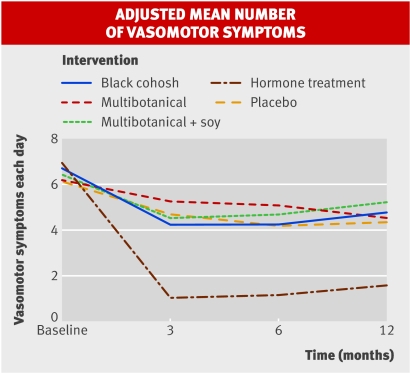Black cohosh alone or combined with other botanical agents doesn't seem to relieve the vasomotor symptoms of menopause better than placebo. A five arm trial was carried out on 351 women aged 45-55 who had at least two vasomotor symptoms each day at baseline. Women were randomised to receive black cohosh; a multibotanical containing black cohosh and nine other herbs; the multibotanical with dietary counselling on intake of soy; oestrogen with or without progesterone; or placebo.
None of the herbal interventions was better than placebo in relieving the symptoms of menopause at three, six, or 12 months of follow-up, while hormonal treatment, compared with placebo, reduced the symptoms by an average of four symptoms each day. Women who were taking placebo reported as many adverse events, such as nausea and vomiting or headaches, as did women who were taking herbal interventions. Women who were taking hormones reported more breast pain and menstrual disorders.
The results of women randomised to a diet high in soy should be interpreted with caution, says the linked editorial. These women were advised to eat at least two servings of soy a day but ate only an average of 1.1 servings each day. The trial therefore could not give a definitive answer as to whether increased intake of soy improves vasomotor symptoms in menopausal women.
More than 150 000 women were asked to participate but only 351 entered the trial. These women might have had more frequent or severe symptoms than the general population of women entering the menopause. The generisability of the results may therefore be limited.
References
- Ann Intern Med 2006;145:869-79 [DOI] [PubMed] [Google Scholar]
- Ann Intern Med 2006;145:924-5 [DOI] [PubMed] [Google Scholar]



